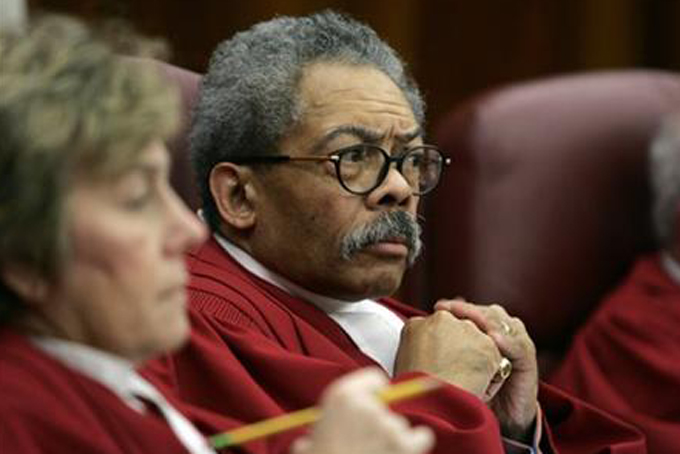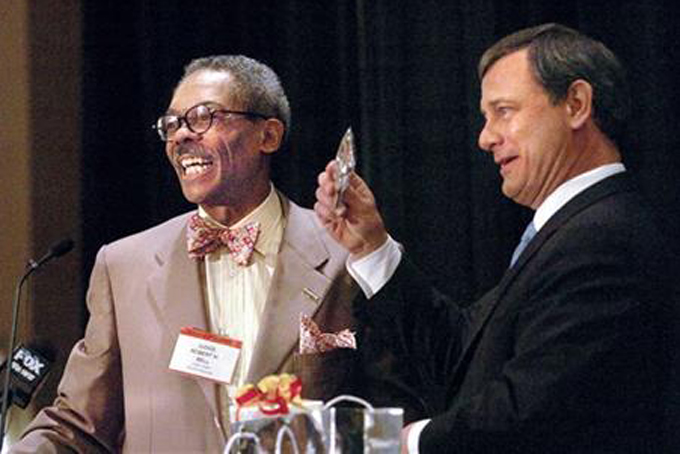
In this Dec. 4, 2006, file photo, Chief Judge Robert M. Bell listens to arguments in the Maryland Court of Appeals in Annapolis, Md. (AP Photo/Chris Gardner, File)
by Jessica Gresko
Associated Press Writer
WASHINGTON (AP) — Robert M. Bell was 16 years old when he recruited classmates to join a sit-in at a downtown Baltimore restaurant. The sit-in was Bell’s first, and he remembers being a little nervous.
On the afternoon of June 17, 1960, the group entered Hooper’s restaurant, and a hostess said she wouldn’t seat them. “I’m sorry, but we haven’t integrated as yet,” she said. The group pushed past her and sat anyway. Police were called, and 12 demonstrators, including Bell, were charged with trespassing. Eventually, the case made it all the way to the U.S. Supreme Court.

In this May 18, 2006, file photo, Robert M. Bell, left, Chief Judge of the Maryland Court of Appeals, presents U.S. Supreme Court Chief Justice John Roberts with a Maryland flag bowtie at the Maryland Judicial Conference in Cambridge, Md. (AP Photo/The Star Democrat, Chris Polk, File)
This month marks 50 years since the case known as Bell v. Maryland was argued in front of the justices. In the 50 years since, Bell went on to become a lawyer and later a judge on Maryland’s highest court, where he sat on the bench with two men who had been prosecutors on his case. He became the court’s chief judge in 1996, a position he held until retiring earlier this year age 70. U.S. Supreme Court Justice Elena Kagan called him a “living legend” before a recent lecture on the case at the Supreme Court.
Bell and others who went to Hooper’s that day said participating in the sit-in was a brief act but part of history.
“I had never thought about what the impact of going into a sit-in demonstration would be in the long haul, but it’s become as much a part of my persona, I guess, or the history that I have been participating in, as anything else I’ve done,” Bell said in an interview last week. He added the case is mentioned every time he is introduced and that he keeps a photo of the group on his iPad.
The sit-in at Hooper’s followed others nationwide. Earlier that year, four Black college students sat down at a lunch counter at a Woolworth’s in Greensboro, N.C., igniting sit-ins to campaign for equal treatment for African-Americans.
LouEllen Brown, a classmate of Bell’s who participated in the Hooper’s sit-in, said the restaurant turned off the lights and air conditioning so it got hot and stuffy. Brown said that at 16, she hadn’t realized she couldn’t eat at certain restaurants because she was Black, and it “opened my eyes.”
Brown, who became a teacher, still has documents that told her which days she had to go to court and said she occasionally shows them to students. For years, they were the only framed item hanging in her home, said Brown, who lives in the U.S. Virgin Islands.
“It reminds me of where I’ve been and where I’ve come from and not to take anything for granted,” said Brown, whose cousin Annette Green, now Annette Newsome, also participated in the sit-in.
Baltimore resident Rosetta Gainey was another demonstrator that day. Then 18 and studying business, Gainey remembers sitting at the restaurant’s counter, right next to a large coffee urn. A waitress, she said, wanted to make the experience as uncomfortable as possible and turned the machine on so it made an unpleasant odor.